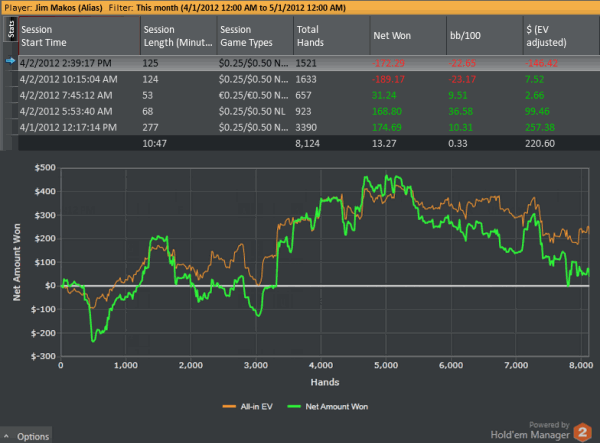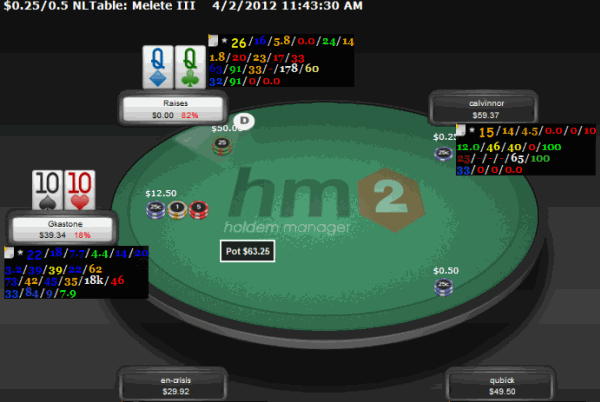Murphy’s law states that by publishing your poker winnings, a downswing is expected in the near future. Since my poker start over at micro stakes went public on Monday, I suffered a 5 buy-in downswing during yesterday’s 6-hour poker session. It was actually three 2-hour sessions for 6 hours of total play, as breaks are necessary to avoid losing focus to the tables. The day started pretty well, winning 2 buy-ins at $50NL 6-max during the first session (with a short break in-between), followed by a mediocre breakeven session. I would have called it a day, as my initial plan was to play for 4 hours per day. Yet, it was of those rare days when I do have some free time in the evening (Eastern European Time here) and I decided to go for another 2-hour session, losing all the day’s winnings and more.

You may notice that I’m talking about downswings which do not keep up with the actual winnings shown in the poker stats of Holdem Manager. If you look at the green line of the poker graph in the image above, I should be talking about an 8 buy-ins downswing. However I’m mostly interested in the orange line that represents the Expected Value (EV) of my bets. That line had a high of $420 and then plunged to $170, losing $250 or 5 buy-ins. If that EV line is going upwards, time will take care of the green line, as long as I am properly bankrolled. Besides, it is the EV line that implies whether you are a good poker player or not.
Moving on with yesterday’s performance, I surely made some important mistakes. For example I recall 4-betting and calling with Tens a loose player’s shove out of position preflop. Although it was a Cut-off vs Button war where loose 3bets are expected (but not from this one – 5.8% 3bet), maybe calling with Tens may have been a better choice. On the other hand, playing against an aggressive player out of position with Tens, not many flops will allow me to continue, leading to some hero – and expensive – calls. It turns out that villain had a mere 1.8 aggression factor which certainly places him in the passive category. If I paid more attention, I would have opted to call and give up scary flops, if he decided to continuation bet.

Calling with Tens against – what turned out to be – his Queens, lost me $32 in Expected Value. If I had decided to fold to his shove, my move would mean -$12.5, therefore keeping $20, almost half a buy-in! Folding a poker hand like Tens against a 0% 4-bettor is also justified I think! Now, what about calling out of position instead of 4-betting? $5,25 would go into the pot preflop. The flop was Kd63d – none of my Tens was a diamond – and I would expect a check behind by the villain. Obviously if he bet that flop, I would have folded (–$5.25 EV so saving 7 more dollars!). Turn was a 5d completing the flush and I would either bet small once (half-pot) into the $10 pot and give up in any case ($10 –EV in total, even better than 4-betting and folding), or fold to any aggression (losing just the initial 5 dollars). So, my five options were:
1) Calling a shove = -$32EV
2) 4betting and folding to his shove = -$12.5EV
3) Calling OOP and firing once on turn = -$10.25EV
4) Calling 3bet and giving up = -$5.25EV
5) Folding to 3bet = -$1.50EV
Since villain’s 4bet/5bet range included just premium hands, it would have been a coin flip (AK) in the best scenario. I consider my move a crucial mistake that cost me at least half of a buy-in. Try adding that kind of costly mistakes up and you’ll quickly find your poker leaks!


